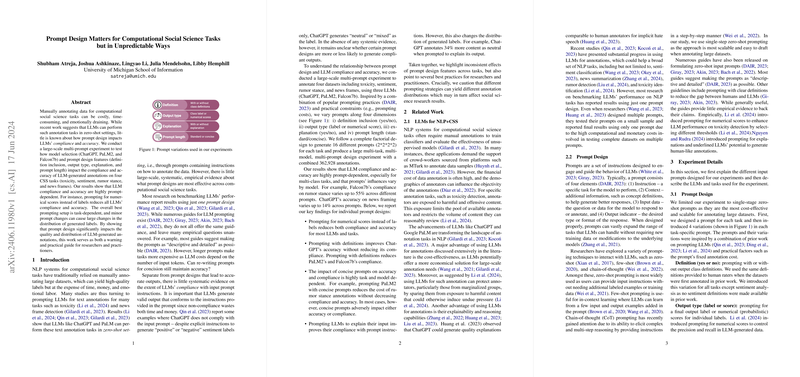Insights on the Impact of Prompt Design in Computational Social Science Tasks
The paper by Atreja et al., titled "Prompt Design Matters for Computational Social Science Tasks but in Unpredictable Ways," performs a comprehensive analysis of how various prompt design features affect the performance of LLMs in generating annotations for computational social science (CSS) tasks. Specifically, the paper considers factors such as the inclusion of definitions, output type, the necessity for explanations, and prompt length. The work scrutinizes these features across different tasks and models, offering valuable insights into performance variability attributable to prompt design.
Experimental Design and Findings
The authors present a large-scale, multi-prompt experimental framework engaging three LLMs (ChatGPT, PaLM2, Falcon7b) to annotate datasets on four CSS tasks, namely toxicity detection, sentiment analysis, rumor stance detection, and news frame identification. The comprehensive factorial design results in 16 prompt variations for each task and over 360,000 annotations. The outcome is a nuanced understanding of how prompt features significantly alter both compliance (adherence to instruction) and accuracy (fidelity to human-annotated ground truth).
Key Observations
- Prompt-Dependent Performance:
- Numerical Scores: Across the board, numerical score prompts diminished both compliance and accuracy. This aligns with existing knowledge about the numerical reasoning limitations of LLMs.
- Class Definitions: The inclusion of definitions yielded mixed results. For instance, ChatGPT's accuracy in toxicity identification improved with definitions, contrasting with PaLM2 and Falcon7b, which exhibited reduced compliance.
- Explanation Requirements: While prompting for explanations enhanced compliance, it also induced significant shifts in label distributions, raising concerns about consistency across tasks.
- Prompt Length: For some tasks, particularly sentiment analysis, concise prompts maintained accuracy while being cost-effective. However, more detailed prompts were necessary for tasks like toxicity detection to maintain high accuracy levels.
- Model-Specific Variability:
- ChatGPT consistently achieved higher compliance and accuracy compared to Falcon7b, particularly evident in its ability to follow numerical instructions and generate correct labels.
- PaLM2 demonstrated high performance overall but varied greatly in compliance and accuracy depending on the task complexity and prompt type.
- Task-Specific Insights:
- Multi-class tasks, such as news frame identification, showed more pronounced variability across different prompt designs compared to binary tasks like toxicity detection.
Theoretical and Practical Implications
The paper underscores the intricate role of prompt design in determining the efficacy of LLMs for annotating CSS datasets. Practitioners should be cautious about the prompt choices, particularly given the substantial shifts in label distributions with minor prompt modifications. This shift could have profound implications for downstream applications, such as public opinion monitoring and content moderation.
On the theoretical front, these findings invite a deeper investigation into the reasoning mechanisms LLMs employ when interacting with varied prompt structures. Understanding these mechanisms could lead to the development of more robust and generalized prompting strategies, thereby enhancing the reliability of LLMs in applied research scenarios.
Future Directions
The paper indicates several avenues for future work:
- Extended Model Comparison: Including a broader range of models, such as GPT-4 or Claude, could offer further insights into generalizability across model architectures.
- Combining Prompts: Investigating the effectiveness of combining results from multiple prompt types to create aggregated, more reliable annotations.
- Mitigation Strategies: Developing methods to mitigate shifts in label distributions possibly through model self-debiasing or enhanced prompt design guidelines.
Conclusion
Atreja et al. significantly contribute to the understanding of LLM prompt design in computational social science tasks. Their work highlights both the potential and pitfalls of LLMs in automated annotation, urging for meticulous prompt design tailored to specific tasks and model characteristics. As LLMs continue to evolve, such detailed evaluations will be crucial in refining their application and ensuring the integrity of research outputs.
